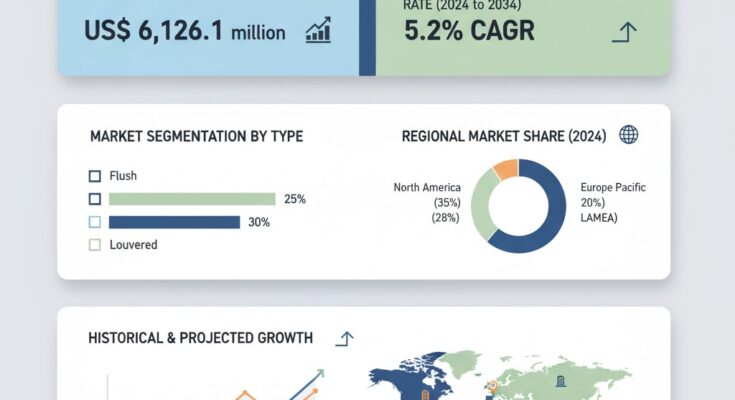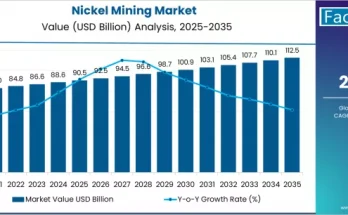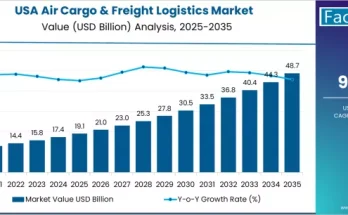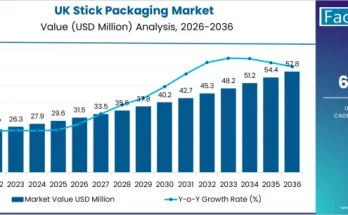The global hollow metal door market is poised for sustained growth, driven by increasing demand across commercial, industrial, and institutional construction sectors. According to a recent report by Fact.MR, the market is estimated at US$ 3,690 million in 2024 and is projected to expand at a CAGR of 5.2%, reaching US$ 6,126.1 million by 2034.
As safety, fire resistance, and durability become top priorities in modern infrastructure, hollow metal doors are gaining traction as the preferred choice for builders, architects, and facility managers worldwide.
Strategic Market Drivers
- Rising Construction and Infrastructure Development
Global infrastructure expansion—particularly in commercial complexes, healthcare facilities, and educational institutions—is propelling demand for high-performance, long-lasting door solutions.
Hollow metal doors are widely used for fire-rated, security, and sound-insulated applications, offering superior resistance to impact, moisture, and corrosion compared to wood or fiberglass alternatives.
In addition, the growing focus on energy-efficient and sustainable building systems is driving adoption of insulated and recyclable steel door assemblies.
- Surge in Industrial and Commercial Applications
Manufacturing facilities, warehouses, and data centers increasingly rely on hollow metal doors for enhanced safety, access control, and environmental separation.
Their high strength-to-weight ratio, customizable designs, and compatibility with advanced locking and automation systems make them essential in industrial environments where security and durability are critical.
- Emphasis on Fire and Security Standards
Stringent building codes and fire-safety regulations across North America, Europe, and Asia are boosting market growth. Hollow metal doors’ compliance with UL fire ratings and ANSI/BHMA standards enhances their adoption in high-occupancy and sensitive buildings such as hospitals, airports, and correctional facilities.
Regional Growth Highlights
North America: Leadership in Safety-Driven Construction
The U.S. dominates the regional market with its strong commercial real estate and institutional building sectors. Increased investments in retrofitting and modernization of aging facilities are fueling demand for energy-efficient and fire-rated hollow metal doors.
Europe: Sustainability and Smart Building Integration
Europe’s focus on eco-friendly materials and energy-efficient architecture supports market expansion. Manufacturers in Germany, the U.K., and France are developing thermally insulated and smart access-enabled door systems that align with the region’s green building standards.
East Asia: Rapid Urbanization and Industrialization
China, Japan, and South Korea are witnessing robust construction activity, supported by smart city initiatives and industrial growth. Local manufacturers are investing in advanced fabrication techniques to meet the region’s increasing need for customizable, high-durability door systems.
Emerging Markets: Infrastructure Modernization
Regions like the Middle East, Latin America, and South Asia are showcasing high growth potential as commercial real estate and government-led infrastructure projects expand. Hollow metal doors are becoming a preferred choice in hospitals, metro stations, airports, and educational institutions, owing to their longevity and security benefits.
Market Segmentation Insights
By Material Type
- Steel (Galvanized, Stainless, and Cold-Rolled) – Dominates the market due to superior strength and corrosion resistance.
- Aluminum and Specialty Alloys – Gaining attention for lightweight and design-flexible applications.
By Application
- Commercial Buildings – Offices, malls, and hotels for fire safety and aesthetic appeal.
- Industrial Facilities – Factories, warehouses, and utilities emphasizing durability and security.
- Institutional Infrastructure – Schools, hospitals, and government buildings requiring compliance with safety standards.
Challenges and Market Considerations
- Raw Material Price Fluctuations – Volatility in steel and alloy costs can impact pricing structures.
- Installation and Maintenance Costs – Higher upfront costs compared to wood doors may deter small-scale buyers.
- Competition from Composite and Aluminum Doors – Lightweight alternatives pose competition in select segments.
- Regulatory Compliance – Adherence to region-specific safety and environmental regulations requires ongoing innovation.
Competitive Landscape
The global hollow metal door market features strong competition, with leading manufacturers focusing on fire-rated certifications, energy efficiency, and automation-ready designs. Strategic collaborations, technological upgrades, and regional expansion remain key priorities.
Key Companies Profiled:
- ASSA ABLOY
- Beacon Metals & Hardware Inc.
- Deansteel Manufacturing Co. Inc.
- Quality Engineered Products Co.
- Overly Door Co.
- Door Components Inc.
- Apex Industries Inc.
- Dunbarton Corporation
- Michbi Doors Inc.
- Al Barrak Group Company
- Mesker Door Inc.
These companies are investing in automated fabrication technologies, energy-efficient designs, and sustainable coatings to meet evolving global standards.
Future Outlook: Toward Intelligent and Sustainable Door Systems
The next decade will mark a transformation in the hollow metal door industry, with innovation centered around sustainability, smart integration, and enhanced fire protection. Manufacturers are expected to leverage digital manufacturing, IoT-enabled access systems, and recyclable materials to enhance product functionality and reduce environmental impact.
With construction and infrastructure investments rising worldwide, the hollow metal door market is set for steady and resilient growth through 2034—empowering safer, smarter, and more sustainable built environments.



